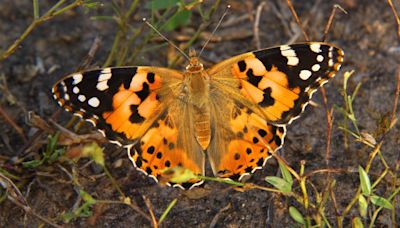Search results
- Dictionarybutterfly/ˈbʌtəflʌɪ/
noun
- 1. a nectar-feeding insect with two pairs of large, typically brightly coloured wings that are covered with microscopic scales. Butterflies are distinguished from moths by having clubbed or dilated antennae, holding their wings erect when at rest, and being active by day.
- 2. a showy or frivolous person: "a social butterfly"
verb
- 1. split (a piece of meat or fish) almost in two and spread it out flat: "butterfly the shrimp using a small sharp knife"
Powered by Oxford Dictionaries
Butterflies are winged insects from the lepidopteran suborder Rhopalocera, characterized by large, often brightly coloured wings that often fold together when at rest, and a conspicuous, fluttering flight. The group comprises the superfamilies Hedyloidea (moth-butterflies in the Americas) and Papilionoidea (all others).
4 days ago · Learn about butterflies, colorful and diverse insects that belong to the order Lepidoptera. Find out how they feed, mate, and undergo metamorphosis, and explore their different families and species.
- The Editors of Encyclopaedia Britannica
Introduction. Butterflies are flying jewels treasured in our urban landscapes, they are also important biological indicators of a healthy ecosystem and share an intimate relationship with plants, by cross-pollinating flowers. Cross pollination can produce young plants which are more resilient to diseases and stressors.
- About The Monarch Butterfly
- Range
- Life Cycle
- Defense
- Migration
- Threats to Survival
- Conservation
- GeneratedCaptionsTabForHeroSec
The monarch butterfly is one of the most recognizable and well studied butterflies on the planet. Its orange wings are laced with black lines and bordered with white dots. Famous for their seasonal migration, millions of monarchs migrate from the United States and Canada south to California and Mexico for the winter.
Monarch butterflies are native to North and South America, but they’ve spreadto other warm places where milkweed grows. No longer found in South America, monarchs in North America are divided into two main groups: The western monarchs, which breed west of the Rocky Mountains and overwinter in southern California; and the eastern monarchs, which bre...
The female monarch butterfly lays each of her eggsindividually on the leaf of a milkweed plant, attaching it with a bit of glue she secretes. A female usually lays between 300 and 500 eggs over a two- to five-week period. After a few days, the eggs hatch into larvae, otherwise known as caterpillars in the moth and butterfly world. The caterpillars’...
Monarchs’ colorful pattern makes them easy to identify—and that's the idea. The distinctive colors warn predators that they’re foul-tasting and poisonous. The poison comes from their diet. Milkweed itself is toxic, but monarchs have evolved not only to tolerate it, but to use it to their advantage by storing the toxins in their bodies and making th...
In the east, only monarchs that emerge in late summer or early fall make the annual migration south for the winter. As the days get shorter and the weather cooler, they know it’s time to abandon their breeding groundsin the northern U.S. and Canada and head south to the mountains of central Mexico, where it’s warmer. Some migrate up to 3,000 miles....
Conservation groups have petitioned the U.S. government to add the monarch butterfly to the Endangered Species Act list. While a decision has not yet been made, it’s clear the species is in decline, facing a number of threats. Western monarchs have declined by more than 99 percent since the 1980s. Eastern monarchs have declined by an estimated 80 p...
As an iconic and loved species, monarchs have received a lot of attention from conservationists. Projects exist across North America. Public awareness campaigns encourage people to plant milkweed in their yards and cities—just look up the type that’s right for your region. There are also a number of citizen scientist opportunities, where regular pe...
Learn about the monarch butterfly, one of the most recognizable and well studied butterflies on the planet. Find out how they use milkweed, migrate, and face threats to their survival.
Butterflies (and moths) are the only group of insects that have scales covering their wings, although some butterflies have reduced scales. They differ from other insects also by their ability to coil up their proboscis.
Check out the lifecycle of a monarch butterfly - from pupa to adult. Subscribe: http://bit.ly/NatGeoSubscribe About National Geographic: National Geographic is the world's premium destination for...
- 2 min
- 4.1M
- National Geographic






